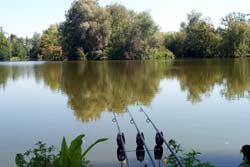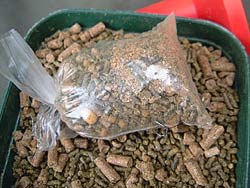| BIG RIK (CARP ANGLER) | ||||||||
Rik started fishing at the age of four on his local tiny tidal river, catching eels and small wild trout on worm. Not having had any angling family members, all his early fishing was solitary and this seems to have carried through to the present. Like most anglers nowadays, he has a full time job and so his fishing time is limited. He currently lives in the depths of Hampshire and within easy reach of some excellent venues. He fishes for most species, although his greatest love is for carp fishing, which is how the majority of his time is spent. He now finds himself more thrilled with overcoming the intricacies and problems associated with catching carp, rather than the actual weight of the fish he catches and the so-called glory that goes with it. |
SPRINGTIME APPROACH Now that the ravages of winter have been thrown off and the beauty of spring has started to show, then we can look to adapt our approach to our irksome quarry. With the increases in ambient water temperature and the marked increase in background food smell, then the carp will be on the move, hunting out new or existing food larders in a bid to shed themselves of the lethargy, bestowed on them by the coldness of winter. Couple this with the yearly call of the spawning ritual being just around the corner, then most of the carp will be looking to bolster their energy reserves to accommodate this. This really is the time of year to be looking for patrol routes and trying to find those ambush points that the fish will constantly visit.
If you know the water reasonably well, then the cross sections of gravel bars or deviations on plateau’s will be immediate points to focus on, as will entrance points to bays. If you are facing a water with little or no knowledge of its make-up (slack person that you are, there is no excuse not to have garnered as much info as possible prior to your visit) then spring will be your best chance of spotting potential feeding spots. You do tend to spot more fish in the height of summer, but these fish tend to be cruising rather than feeding and they can sometimes lead you to fish in areas where they don’t readily feed. So, you’ve spent the last few visits spotting fish, spying patrol routes and extensively using the marker float afterwards as to ascertain why the fish were there. So with this wealth of knowledge stored within the grey matter, we can now look at our baiting approach to attempt to ensnare our quarry.
Always remember that bait application and quantities are governed by the number and size of other species, as well as your target species. A shoal of roach can devour as much of your free offerings as a shoal of large tench, so just because there are no large tench or bream in the water, don’t discount any silver fish in your equations. This will also have a bearing on your application, be it a constant topping up approach or larger quantities less often. This may also determine your choice of bait, be it freebies or hookbaits.
Carp being curious creatures may well be encouraged into the area and into feeding by the presence of other feeding fish, but will this be offset by you creating more disturbance by catching/spooking these other fish or by having to re-bait? Only you can decide on the best approach and this will be gained through experience and on a trial and error basis. I normally employ two very different tactics at this time of year. They are starkly different in their concepts because of the unpredictability of both the weather and the carp. My first tactic is to utilise a high attract bait and PVA bags of oily pellets and either cast to showing fish, or to likely spots if the carp aren’t readily showing themselves. If the carp aren’t really getting their heads down, or if you are restricted to short sessions, then this is a very good and effective method to employ. If you are at the lake for an extended period or you know that the carp are actively feeding, then my favourite springtime approach is mass baiting with particles. Throughout the winter the insect life has been nil and now that the warmer weather is here the creatures that live in the silt and weed start to proliferate and the carp will take full advantage of this.
Soaked for 48 hours with some flavouring, Hutchy’s Maplecreme being my most productive, and then boiled for 20 minutes, these baits can absolutely take waters apart at this time of year. Piling them in on a mass scale seems to make them more effective. As the situation dictates, it’s either all in at the start or a constant topping up process.
Use your marker float accurately and then get the spod rod out, or utilise the maples inherent weight and shape, if it’s within 30 yards, and get the catapult out. A very good, yet under-rated area that is often overlooked at this time of year is to fish into the emerging new weed growth. Getting a good spread of mass baits over a new weed bed, if the carp are visiting it, can lead to some memorable sessions. Remember with the ever changing and unpredictable weather at this time of year, means that you need to be flexible with your approach and you will need to read the situation and adapt accordingly. I hope that this short article has given you a few things to think about, with the approach of what some would say, is the most productive time of the year. |















